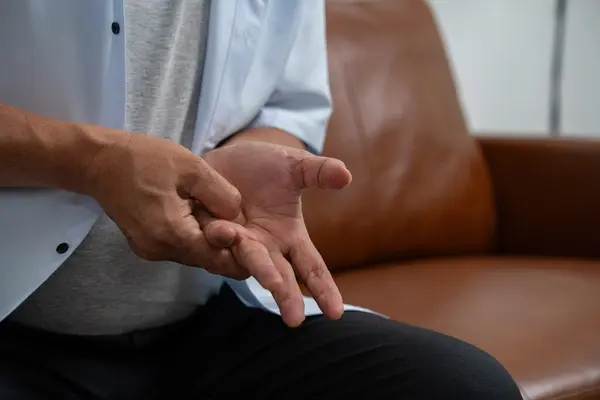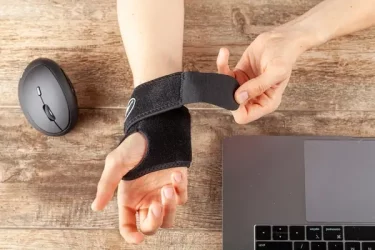If you are experiencing discomfort in your hands or wrists, you may be suffering from carpal tunnel or arthritis. Both are conditions that can affect the hands and wrists, but they have distinct characteristics and causes. If you suspect you’re suffering from either condition, it’s important to understand the differences between the two in order to seek appropriate treatment.
So, what’s the difference between arthritis and carpal tunnel? Let’s find out!

Carpal tunnel surgery at a glance
- Waiting time: 4 – 6 weeks
- Price: £2,249
- Payment options: self-pay, insured
How to tell the difference between carpal tunnel and arthritis
There are several key factors to consider when comparing carpal tunnel syndrome and arthritis. These include the symptoms, their location on the body, and when they occur.
Symptoms
Symptoms of carpal tunnel syndrome can include:
- a tingling sensation or a feeling of pins and needles in the fingers
- a numbness or pain in the hand
- aches or pains in your fingers, hand or arm
- a weak thumb or grip when using one or both hands.
There are several stages of carpal tunnel and symptoms may come on gradually, developing over time.
The symptoms of arthritis often include:
- joint pain
- stiffness
- pain and swelling
- reduced range of motion.
These symptoms are often worse in the morning or after periods of inactivity. Typically, only one or two joints in the hand are affected. It’s rare to experience symptoms in the whole hand.
Location
Carpal tunnel’s focal point is in the wrist and hand. The carpal tunnel itself is a narrow passageway formed by bones and ligaments in the wrist. This houses the median nerve and tendons responsible for flexing the fingers.
Arthritis can affect any joint in the body but it most commonly occurs in people’s spine, knees, hips, and hands.
When it occurs
Often, carpal tunnel syndrome symptoms occur at night or during activities that involve fixed positions of the wrist wrist joint. These are most commonly:
- driving
- holding a phone
- typing
- using a computer mouse.
Arthritis symptoms are often most noticeable during activity involving the affected joints, after long activity, or at the end of the day. Symptoms can also worsen after long periods of inactivity.
Causes
Carpal tunnel is usually caused by the median nerve getting compressed by a thickening ligament which forms the roof of the tunnel. This can be contributed to a number of conditions, sometimes in combination with, including:
- pregnancy or hormonal changes
- obesity
- certain medical conditions like diabetes
- having a narrow carpal tunnel
- wrist arthritis or fractures.
There are several different types of arthritis, each of which has its own causes. The most common types of arthritis in the UK are osteoarthritis and rheumatoid arthritis. Rheumatoid arthritis is caused by the body’s immune system attacking the joint. Osteoarthritis is caused by wear and tear or previous injury or infection of the joint. There is often an inherited pattern of arthritis.
Other risk factors include old age and obesity.
Diagnosis
Your GP will usually be able to diagnose carpal tunnel syndrome with a few questions about your symptoms. He or she may also check your hand strength and appearance. If they are not able to confidently diagnose you during your appointment, they may refer you for a follow-up at a hospital for tests. These may include an ultrasound scan or a nerve conduction study.
To diagnose arthritis, your GP will start by reviewing your medical history, the symptoms you’re experiencing, and how the pain is affecting your activities. They will also examine and move your joints. This may be followed up with lab tests, blood tests, and imaging of the affected joints.
Treatment
Treatment strategies for carpal tunnel syndrome aim to alleviate pressure on the median nerve and manage the symptoms. This can involve a multi-faceted approach, including:
- rest and immobilisation of the affected hand
- physiotherapy to strengthen and support the hand and wrist
- the use of wrist splints to maintain a neutral position
- pain and anti-inflammatory medications
- injection of steroid around the nerve
- in certain cases, carpal tunnel syndrome surgery may be considered to release the pressure on the median nerve.
Arthritis can’t be cured. However, all is not lost; there are several treatment options available to alleviate the symptoms. These can ease the pain and slow its progression, especially in the early stages. These include:
- pain and anti-inflammatory medication
- exercise such as joint, cardio, balance exercises and physiotherapy
- weight loss to reduce stress on weight-bearing joints
- injection of steroid or other substances into the joint
- joint replacement surgery for a damaged joint
- some patients find dietary supplements such as turmeric, glucosamine, or garlic oil can help their symptoms. Whilst there is limited scientific evidence for their effectiveness, they are mostly safe to take.
Carpal tunnel vs arthritis – similarities and differences
When looking at whether you’re suffering from carpal tunnel or arthritis, it’s worth bearing in mind the key similarities and differences between the two. We explore what these are below.
Similarities
- both conditions can cause similar symptoms of pain and discomfort
- both symptoms may worsen during activity involving the affected joint
- obesity can be a contributing factor
- pain and anti-inflammatory medication can be used in treatment.
Differences
- carpal tunnel primarily affects the thumb, index, middle, and ring fingers while arthritis can affect many different joints in the body
- limiting activity can help with carpal tunnel but may make symptoms worse for arthritis
- arthritis is more common in older people. On the other hand, carpal tunnel syndrome can affect any age and can be effectively treated through non-surgical and surgical interventions.
When to seek treatment
If you are experiencing persistent hand or wrist pain, numbness, or any other symptoms, it’s important to consult a healthcare professional for an accurate diagnosis and appropriate treatment plan.
Carpal tunnel vs arthritis FAQs
Not yet found the information you’re looking for? Our dedicated carpal tunnel vs arthritis FAQs can help!
No, carpal tunnel syndrome is not directly related to arthritis. They are separate conditions with different underlying causes. However, arthritis can be a contributing factor to carpal tunnel syndrome.
No, carpal tunnel syndrome does not progress into arthritis. They are different conditions with their own causes and approaches to treatment.
Yes. Unfortunately, it is possible to have both arthritis and carpal tunnel syndrome simultaneously, especially as arthritis of the hand or wrist can make carpal tunnel syndrome more likely.
While there are some self-tests available, it is important to consult a healthcare professional for a proper diagnosis. They will perform a thorough examination and may order additional tests if necessary.
Carpal tunnel syndrome may improve by itself over time. In more severe cases, however, you may be referred for surgery to release the pressure on the median nerve. Carpal tunnel is a successful surgery, with around 90% of patients seeing a positive result.






